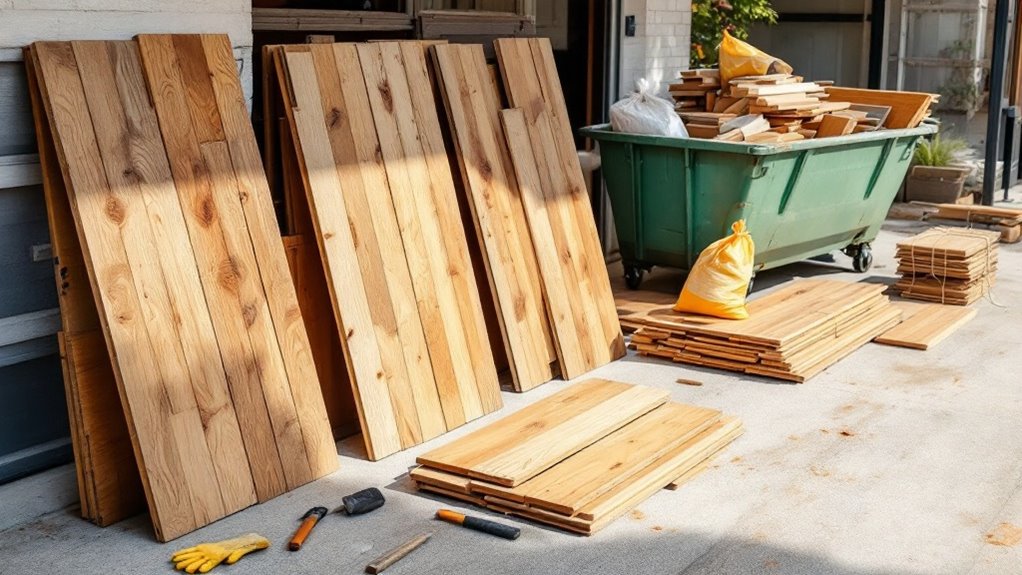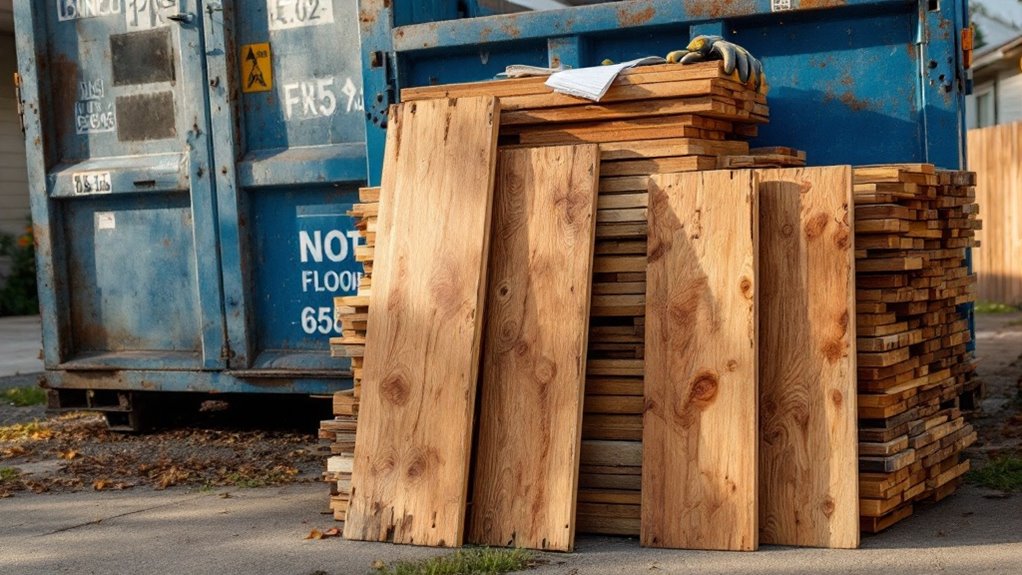You can dispose of hardwood floors through several methods, including renting a dumpster, hiring professional removal services, or pursuing eco-friendly options like recycling and repurposing. For DIY removal, you’ll need basic tools like pry bars and hammers to carefully lift the planks. Professional services cost $1-$1.50 per square foot but include equipment and disposal, while DIY runs $0.25-$0.50 per square foot. Understanding your specific project’s requirements will help you choose the most cost-effective and efficient solution.
Key Takeaways
- Rent a dumpster for cost-effective disposal, ensuring proper permits and coordinating delivery times with your local waste management service.
- Contact reclaimed wood companies to sell or donate usable hardwood flooring for sustainable recycling and repurposing.
- Break down flooring into manageable sections using a circular saw, then remove planks with pry bars for easier disposal.
- Transform old hardwood into mulch for gardening, or repurpose it into furniture and home projects.
- Hire professional removal services for comprehensive disposal, including debris cleanup and environmental compliance.
Understanding Hardwood Floor Disposal Options

When it’s time to remove your old hardwood flooring, you’ll find several practical disposal options available. Renting a dumpster stands out as one of your most cost-effective choices, letting you handle the disposal at your own pace. You’ll want to check with your local authorities first, as some areas require permits for public placement and have restrictions on chemically treated wood. For minimal site disruption, our team carefully coordinates delivery and pickup times to protect your property and landscaping.
For a more sustainable approach, consider connecting with reclaimed wood companies in your area. These specialists can transform your old flooring into new, beautiful projects, giving your materials a second life. This option not only helps you avoid improper disposal but also prevents environmental issues. Plus, you’ll be joining a community of environmentally conscious homeowners who prioritize responsible waste management. Investing in proper hardwood floor disposal can be worthwhile, as these floors typically offer a 70-80% return on your initial investment.
Step-by-Step Guide to Floor Removal
Before starting the removal process, you’ll need essential tools like pry bars and hammers, along with safety equipment such as protective eyewear and dust masks.
You’ll want to begin by clearing the workspace and laying down tarps to control debris and dust during the removal. Starting from the room’s edges, use your pry bar to carefully lift each plank while being mindful not to damage the subfloor underneath.
Tools and Safety Equipment
Removing hardwood floors safely requires specific tools and protective equipment to guarantee both efficiency and personal safety. You’ll need essential items like a circular saw, pry bars, and a sturdy hammer to effectively tackle the job. Don’t forget your protective gear, including safety glasses, dust mask, and steel-toed boots to shield yourself from potential hazards.
For the best results, remember these indispensable steps:
- Gather measuring tools like a tape measure and chalk for precise markings
- Set up dust containment systems and plastic sheets to protect your space
- Keep nail removal tools handy, including a nail claw and curved vice grips
Having the right equipment not only makes the job easier but also confirms you’re part of the community of responsible DIYers who prioritize safety and proper technique.
Plank Removal Techniques
The successful removal of hardwood planks hinges on a systematic approach and proper cutting techniques. Start by cutting your flooring into manageable 1-2 foot sections using a circular saw, setting the blade depth just shy of the flooring thickness to protect your subfloor.
To remove individual planks, you’ll want to use a box cutter to slice along the cracks on both sides until you’ve completely severed the tongue. Then, gently pry up each section with your pry bar.
For stubborn planks, especially those near walls or built-ins, you’ll need your multisaw to carefully cut through the ends.
Remember to work perpendicular to the plank direction to minimize the risk of hitting nails, and don’t forget to wear your dust mask and safety glasses throughout the process.
Eco-Friendly Disposal Methods
You can transform your old hardwood flooring into useful mulch for gardens and landscaping projects through local recycling centers. If you’re looking for green disposal options, consider repurposing the wood for furniture, feature walls, or raised garden beds.
These eco-friendly alternatives not only reduce landfill waste but also support sustainable practices that help protect forests and minimize environmental impact.
Recycling Wood Into Mulch
Converting old hardwood floors into mulch offers an environmentally conscious disposal method that benefits both homeowners and the ecosystem. When you’re ready to transform your flooring into mulch, you’ll need to properly sort and prepare the wood first. Remove all metal hardware and guarantee the wood is clean and free from contaminants.
The wood-to-mulch process involves these key steps:
- Sort your hardwood by type and quality, separating treated from untreated pieces
- Cut the flooring into manageable segments for easier processing
- Send the prepared wood to a recycling facility where it’s ground into mulch using specialized equipment
You can find local recycling centers that accept hardwood flooring by searching online or contacting your community’s waste management services. The resulting mulch can beautify landscapes while supporting sustainable practices.
Green Disposal Alternatives
Seeking eco-friendly ways to dispose of your old hardwood floors? You’ll find several green alternatives that help protect our environment while being part of the sustainability solution. Start by connecting with local recycling centers that specialize in wood materials. These facilities guarantee your hardwood doesn’t end up in landfills and instead gets repurposed for new uses.
Partner with eco-friendly waste management services that follow environmental regulations and proper disposal methods. They’ll help you responsibly dispose of your flooring materials while supporting forest preservation efforts. Remember, every piece of wood you recycle reduces the demand for new timber and helps prevent deforestation. By choosing green disposal options, you’re joining a community of environmentally conscious homeowners who are making a real difference in protecting our planet’s resources.
Professional Removal Services Vs DIY
When it comes to removing hardwood floors, choosing between professional services and DIY removal presents distinct trade-offs with respect to safety, efficiency, and cost. Professional teams come equipped with specialized tools and expertise to handle various flooring types, while you’ll likely struggle with limited equipment and adhesive removal if attempting DIY.
Professional services provide:
- all-encompassing insurance coverage protecting your property
- Industrial-grade equipment for efficient removal and cleanup
- Proper waste disposal and environmental compliance
If you’re considering DIY, you should know it’s more than just prying up boards. You’ll face challenges with adhesive removal, debris disposal, and potential safety risks. Without professional equipment and expertise, you might spend more time and effort while potentially compromising the quality of the job.
Cost Analysis and Budget Planning

Understanding the financial aspects of hardwood floor disposal helps you make an informed decision between DIY and professional services. You’ll typically spend between $1.50 to $2.50 per square foot for total removal costs, including labor and materials. For a 300-square-foot room, expect to budget $325-$700.
| Cost Factor | DIY Range | Professional Range |
|---|---|---|
| Material Removal | $0.25-0.50/sq ft | $1-1.50/sq ft |
| Equipment | $50-200 | Included |
| Disposal Fees | $100-300 | $200-400 |
| Labor Hours | 15-25 hrs | 8-12 hrs |
| Permits | $0-100 | Included |
You can reduce these costs by recycling materials, selling usable pieces, or donating to community projects. Many contractors will negotiate prices, especially if you’re flexible with timing or willing to handle some preparation work yourself.
Tips for Safe and Efficient Disposal
Safe and efficient disposal of hardwood floors requires careful planning and proper execution to protect both you and the environment. As a responsible homeowner, you’ll want to prioritize safety while managing waste effectively.
Before you begin the removal process, guarantee you’ve gathered these essential items:
- Personal protective gear including safety glasses, dust mask, and heavy-duty gloves
- Proper tools like pry bars, mallets, and a circular saw
- A wet/dry vacuum for dust control and cleanup
Remember to use a magnet to collect any stray nails or staples during the removal process. You’ll also want to contact your local recycling centers or waste management facilities to determine the best disposal method for your specific flooring type, especially if it contains harmful chemicals.
Frequently Asked Questions
Can Hardwood Flooring With Termite Damage Be Recycled?
You can recycle hardwood flooring with minor termite damage by removing affected sections, but if there’s extensive damage or chemical treatment, you’ll need to explore disposal alternatives.
How Long Does Hardwood Floor Disposal Typically Take for an Average Home?
You’ll typically need 2-4 days for complete hardwood floor disposal in an average home. If you’re doing it yourself, plan for up to a week, depending on your experience level.
What Cleaning Is Required Before Disposing of Hardwood Floors?
You’ll need to dry dust, vacuum with a soft brush, and mop with a pH-neutral cleaner. Guarantee surfaces are completely dry and free from debris before disposal begins.
Are There Seasonal Restrictions for Hardwood Floor Disposal in Different Regions?
You’ll find that seasonal restrictions rarely affect hardwood floor disposal. Check your local waste management facility’s hours, as they might adjust their schedule during winter months or holidays.
Can Hardwood Floors Containing Asbestos Be Disposed of With Regular Waste?
You can’t dispose of asbestos-containing hardwood floors with regular waste. You’ll need to follow strict regulations, hire certified professionals, and use authorized disposal facilities for safe handling.
Conclusion
When you’re ready to dispose of your hardwood floors, you’ve got several viable options. Whether you choose to donate usable pieces, recycle through local facilities, hire professionals, or handle the removal yourself, make sure to follow local disposal regulations. Remember to prioritize safety during removal and consider the environmental impact of your disposal method. With proper planning, you can efficiently and responsibly dispose of your old hardwood flooring. If you need help in disposing of fireplaces check out our demolition fireplace article.